
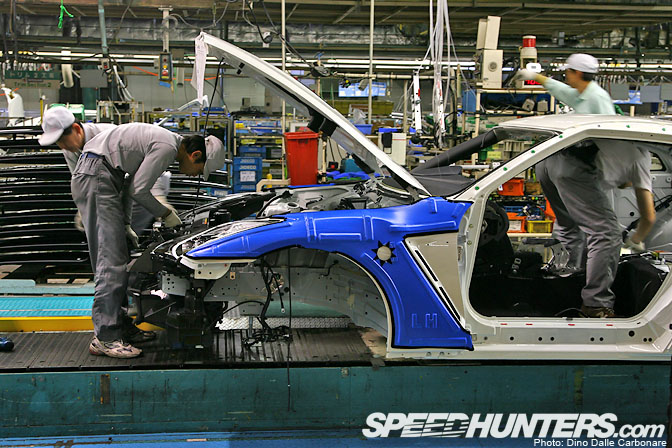
Having posted a few R35 GT-R features so far I thought it would be interesting to see how the most affordable supercar on the planet is actually put together. It's not often that manufacturers let you wander around their production lines, but Nissan has nothing to hide and gave us an in depth tour of how a car of this caliber comes together.

It all begins at the Yokohama plant, where the mighty VR38DETT is put together. The GT-R's engine couldn't have been assembled in a better place as this is where the RB26 and S20 engines of the two previous generations of GT-Rs were made. Away from the automated production lines where the MR motors are built, destined for use on smaller Nissan and Renault vehicles, is a separate climate and humidity controlled room. This is where a team of takumi or "specialist" skilled workers create the most powerful production car engine Nissan has ever built.
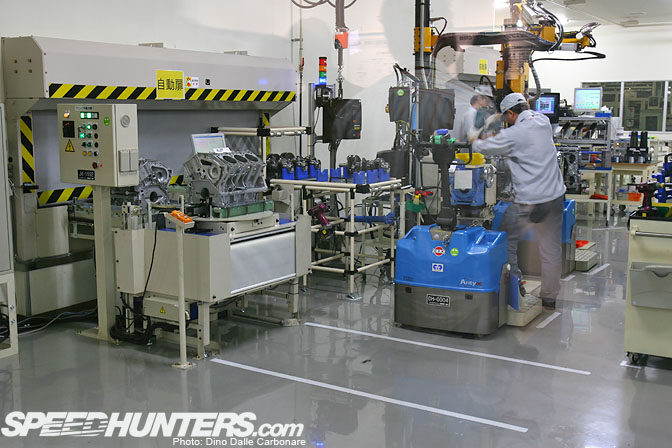
As soon as the prepped VR38 engine block enters the clean room it is placed on a rig and a single technician takes care of building it from start to finish, as he moves around the various areas of the room where different build steps are carried out. It reminded me more of an F1 workshop than a run of the mill car factory, perfectly exemplifying how much Nissan have put into the GT-R project. It takes about 200 minutes to built one engine and at the time of the visit production was set at 27 units per day. With the GT-R now on sale in Europe there is a good chance engine production may have increased to meet demand.
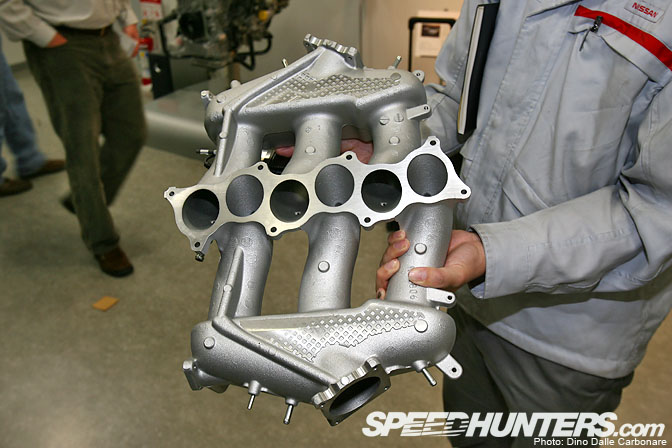
Here is a technician showing us the aluminum intake plenum, a part that has been carefully designed to provide a balanced flow of air to each of the VR38's six cylinders.
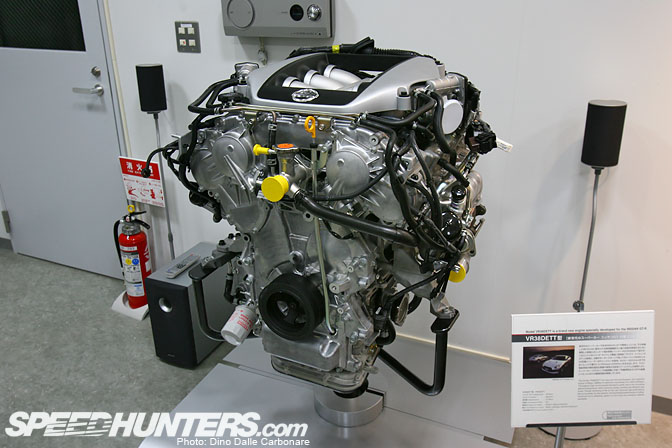
Once each engine is produced it is placed on a bench dynamometer where a series of power and torque checks are carried out. At the same time each engine is put through a brake-in cycle which lasts 60 minutes, something that needs to be done to guarantee it will perform as it should straight out of the box. From the Yokohama plant the engines are packaged and sent to one of Nissan's biggest plants up in Tochigi-ken, which is precisely where we headed next!
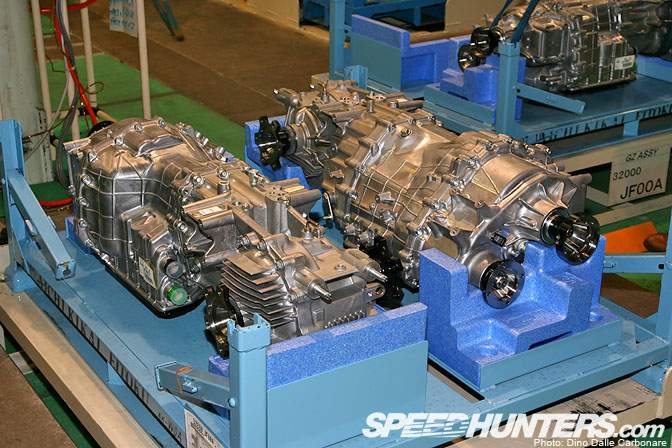
Like the engine, the Borg and Warner GR6 dual clutch transmission, arrives already built to the Tochigi plant. It is all one piece with the rear differential housing, while on the opposite side you can see where the two propeller shafts will be connected to.
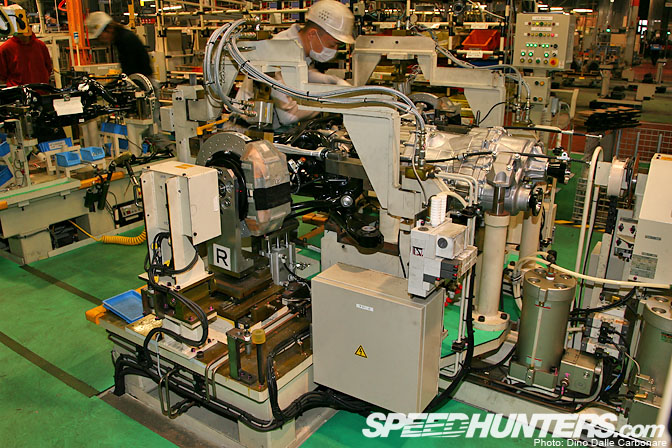
Both the front and rear subframes assemblies are build off the car on special rigs. Here you can see the rear being put together along with the gearbox, suspension arms, hubs and brakes.
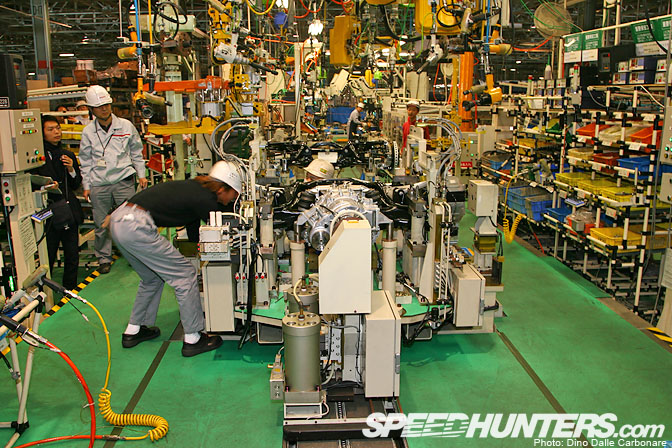
Once everything is put together the front and rear suspension is laser-aligned and then lifted from the rig and brought to the production line to be fitted to the car.
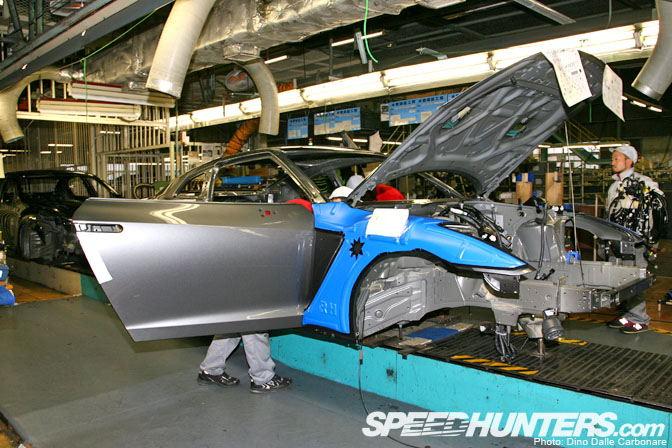
The GT-R is assembled on the same production line as other Nissan premium vehicles like the Cima (Infiniti Q45) and the Skyline (Infiniti G37),
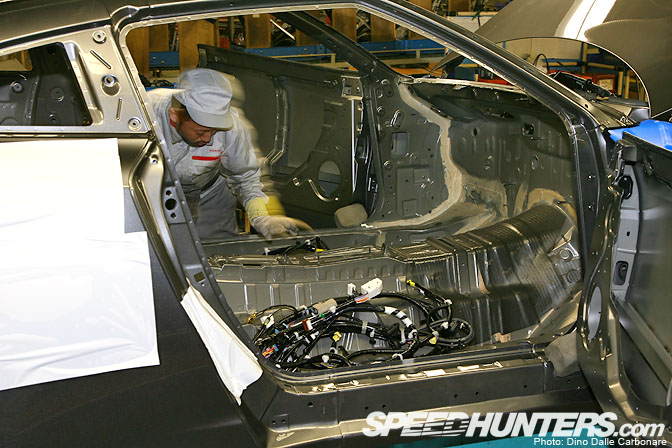
After painting this is one of the first steps of the build process. You can see the wiring loom ready to be installed in the bare-metal interior.
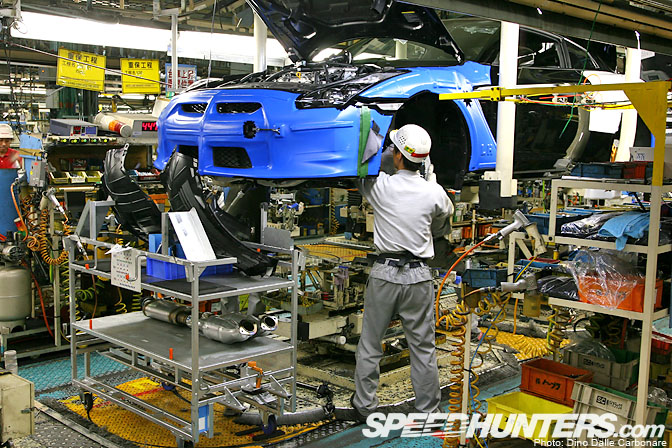
Specially molded body protectors are applied to prevent scratches and damage when the cars are being built.
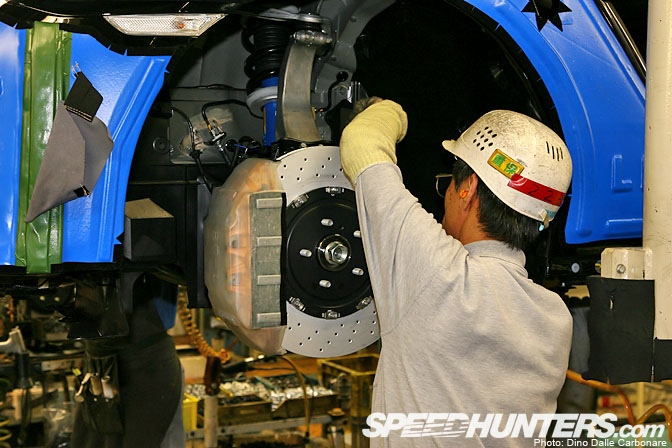
The front pipes of the exhaust system were being fitted here along with the wheel-arch inner liner. Just look at the size of the front brakes!
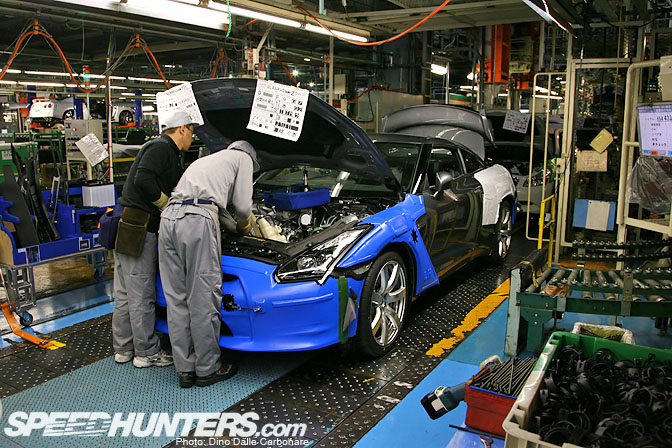
Engine ancillaries are then addressed, like the radiator overflow tank being fitted here.
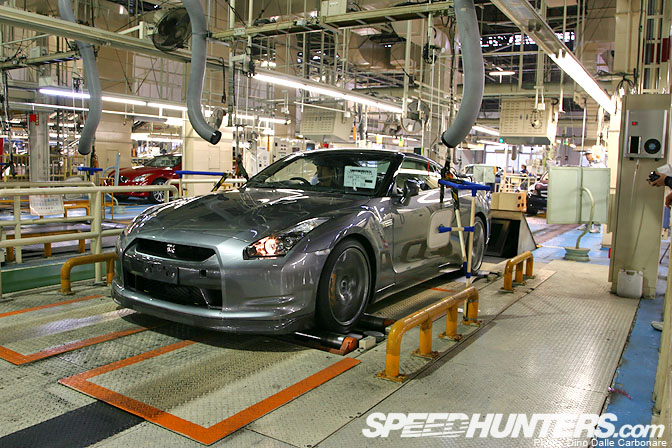
Once the R35 is completed it is put on a rolling-road for the first set of tests. The cars are driven up to 120 km/h to check everything is working fine. Once this test is completed…
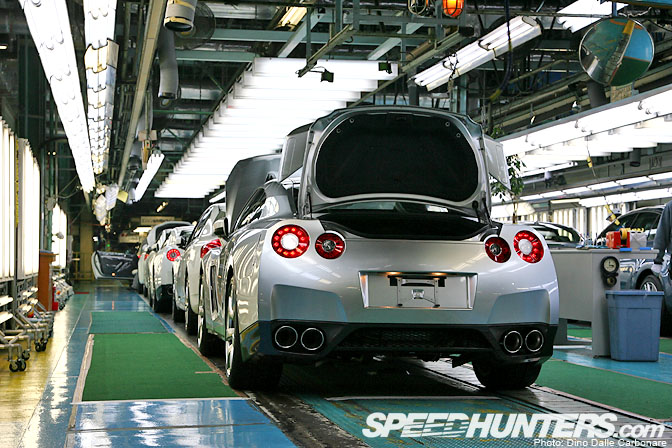
…the cars are driven onto the brightly lit quality control line where fit and finish, body tolerances and paint quality are meticulously looked at.
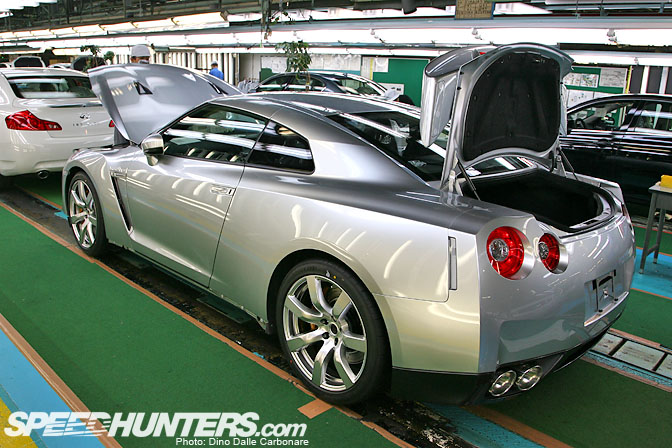
The interior, engine bay and trunk areas are also checked over, as well as door and trunk operation.
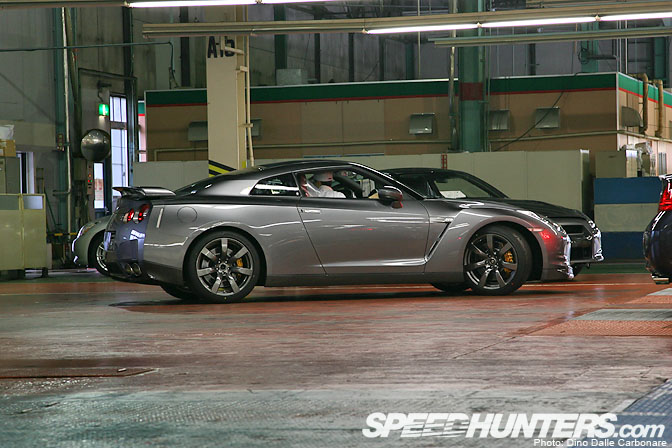
It is then off the production line and to one side of the factory building where the cars wait for their final tests.
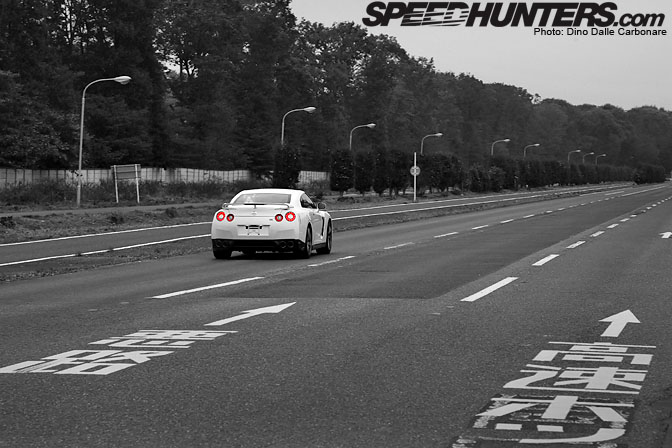
One by one the GT-Rs are driven out onto the test course that wraps around the factory grounds. Here a group of testers drive the cars to check that everything is working as it should as well as taking care of some bed-in procedures. These are done to brake-in the Brembo brakes and the clutches in the GR6 dual-clutch gearbox. To do this the cars are lined up, accelerated hard up to the top of third gear at which point the tester goes hard on the brakes keeping his right foot planted on the accelerator.
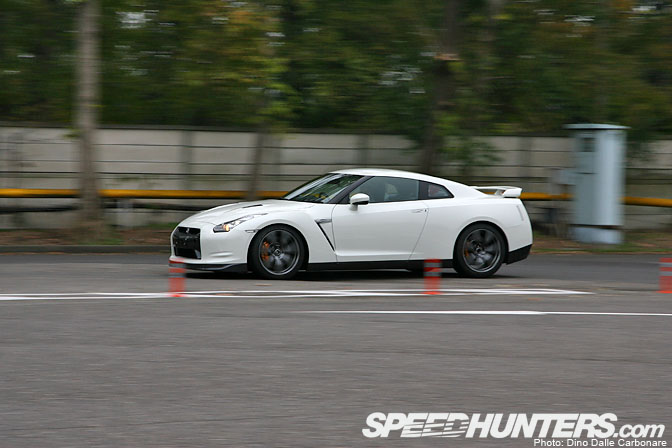
This is repeated a few times after which the cars are taken back into the factory to have the clutches adjusted and tolerances checked.
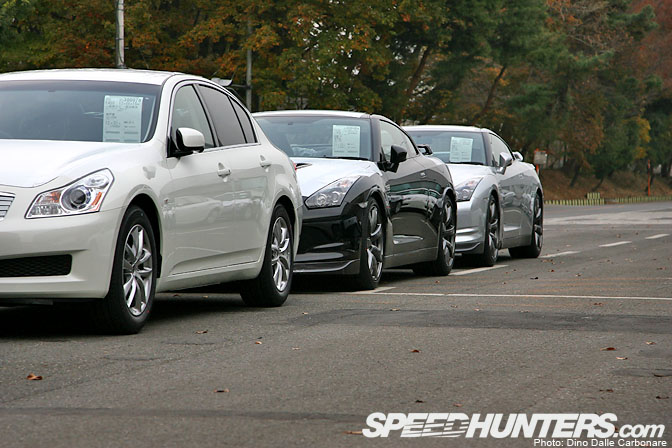
With the cars built, run-in and final checks taken care of they are prepared for pick up. It is then off to the dealers where they will be delivered to their new owners. Despite the engine, drivetrain and brakes having been run-in properly Nissan still suggests owners take it easy for the first 2000 km, something I'm sure would be a torture to do!
Next up it's off to Sendai Hi-land to sample the most extreme R35 GT-R to date, the SpecV.
-Dino Dalle Carbonare






Amazing. I don't see how aftermarket brake upgrades would do anything. I wonder though why nissan would use drilled rotors. I have just seen to many crack to trust them on the street at least.
I dont want a GTR, I want the machines that are makin em!
Amazing ! Its a pleasure to work as a technician there =D
Haha good call Swerv13... can I pop by when you get them???
"Amazing. I don't see how aftermarket brake upgrades would do anything. I wonder though why nissan would use drilled rotors. I have just seen to many crack to trust them on the street at least."
Aftermarket brake upgrades are about a lot more than the size and cross-drilling. The materials used, the ventilation/heat dissipation, the pistons and calipers are all important factors.
As for being cross-drilled, it's most likely more a cool looking design feature than anything. However, manufacturers who put oem drilled or slotted rotors on their cars make sure they adhere to some sort of standard as the brakes do come stock on a production car.
Two thumbs up man!
great post loved reading it
oh and brewed
"Amazing. I don't see how aftermarket brake upgrades would do anything."
there was a post like a week ago talking about a R35 with after market brakes
Thanks for the amazing article Dino, it's very interesting to see how the GT-Rs are made!
"Amazing. I don't see how aftermarket brake upgrades would do anything. I wonder though why nissan would use drilled rotors. I have just seen to many crack to trust them on the street at least."
The rotors you see that are cracking are cheap rotors, real crossdrilled rotors (ie. coming on Porsches) do have stress cracks, but that is more from HEAVY abuse on the track.
I wasn't aware Borg Warner and American company was the supplier of the GTR transmissions.
this is awesome.... reminds of that one video with nomuken at the assembly line of the 180sx.....
http://www.youtube.com/watch?v=Po4i0HHrAWA
and heres vid on the GTR!
http://www.youtube.com/watch?v=hBHnPvf8pYI&feature=related
Great stuff!
Awesome article. It's very interesting to see how these wonderful cars are made.
Hi
I want to say Nissan cars were the best one.
I am auto-mechanic, (Tochigi ken,Yoshida jidoosha de kenshushimashita).
May i have your workshop manual or CD for yours modern cars
Borg Warner Transmissions? They're made Aichi Kikai. (Who also make a lot of the smaller engines).
There's a big hint on the delivery stilages
The rotors you see that are cracking are cheap rotors, real crossdrilled rotors (ie. coming on Porsches) do have stress cracks, but that is more from HEAVY abuse on the track.
Cross drilled is for cleaning and for cooling/venting
Naturally the cross drills provide more surface area for cooling
Secondly they assist with brake dust/residue/gasses from heavy braking.
I think slotted is generally more reliable, and has similar performance in terms of gas venting and cleaning.
and to add to above.
you will be trading longevity and reliability for performance -- how much performance can also be questioned.
Awsome!
drop one of those lumps into an ariel atom and stand back... lol
I think now everyone knows the choices on the brake system and also considering just how many top engineers worked on R&D and designing this car with the mega $$$$$$$$$ figures put into it I am certain that there is a real specific reason for Nissan engineers for why they chose every component on the car. Remember, one of the targets was to have a car from off the production line ready to beat a Porsche lap time on the "RING"!
Swerv13: the machines and custom built robots that build the cars in the Japanese factories are just breath taking! simply amazing!
nice one swerv13. cool pics, those brakes are massive!! although ive read some tuners do upgrade them, they are good, but there is always better i suppose.
Takumi builds the engines?!?
He sure has come on well
no takumi means "specialists" lol
Yes boys get mine in two days love it
???
???
To: Khamis Saleh Khamis,Tanzania Zanzibar p. o .box 1586.
Sorry man, I think it's just a tour, not an actual production spec website.
On the other hand, nice write up!
I saw three of the GTR's at my local Nissan dealership in Perth today
This is a fantastic article.
You really kick ass at your job.
"At the same time each engine is put through a ***brake-in*** cycle"
From so-called car people it makes me want to cry/scream to see this.
So, considering they drive each and every vehicle in 3 different situations, does that mean every car has miles on the odometer off the lot? OR, do they hook up the odometer after all tests are complete. Just curious, as I did purchase mine new, but it had like 60 miles on it. I knew they didn't let anyone test drive it, as it was pre-ordered. Just curious if anyone knew, not really important...GREAT ARTICLE!
If there was 60 miles on your "new" vehicle, then someone definitely test drove it... and quite a bit. I got mine brand spanking new with strict instructions for the master tech receiving the vehicle to do "minimal driving" on it once it arrived. When I picked up my GT-R, it only had 26 miles on it.
I know about 30 milea were put on due to them having to run it to the Nissan body shop to get all of the ground effects painted to match the car (15 miles each way). The dealer invoice actually shows 29 miles (checked after first post). So I guess that means they must test them with odometer active about 20+ miles. Just more curiousity than anything.
I will turn 60 years old in November....all of my "Kids" are out of the house and have their own homes and families ......I AM GOING TO BUY ME A NISSAN GT-R 2010.
Yes, 25~30 miles upon delivery is normal and expected. You didn't really mention the body shop tidbit in your first post... sounded like you took delivery of a brand new, fresh off the boat GT-R with 60 miles.

Congrats Robert, you'll love it!
how they build the GT-R is simply awesome... when will i get my hands on one...
i cant wait to take one GT-R for a spin...